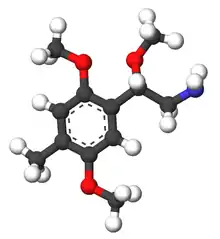BOD (psychedelic)
BOD (4-methyl-2,5,β-trimethoxyphenethylamine) is a lesser-known psychedelic drug. It is the beta-methoxy analog of 2C-D and was first synthesized by Alexander Shulgin. In his book PiHKAL, the dosage range is listed as 15–25 mg with a duration of 8–16 hours.[1] Its reported effects include mild open-eye and moderate closed-eye alterations in visual perception, enhancement of conversation and sense of humor, and unpleasant physical effects such as nausea and lethargy.[2] Very little data exists about the pharmacological properties, metabolism, and toxicity of BOD.
 | |
 | |
| Names | |
|---|---|
| Preferred IUPAC name
2-(2,5-Dimethoxy-4-methylphenyl)-2-methoxyethan-1-amine | |
| Other names
4-Methyl-2,5,β-trimethoxyphenethylamine 2-(4-Methyl-2,5,β-trimethoxyphenyl)ethanamine | |
| Identifiers | |
CAS Number |
|
3D model (JSmol) |
|
| ChemSpider | |
PubChem CID |
|
| UNII | |
CompTox Dashboard (EPA) |
|
InChI
| |
SMILES
| |
| Properties | |
Chemical formula |
C12H19NO3 |
| Molar mass | 225.288 g·mol−1 |
Except where otherwise noted, data are given for materials in their standard state (at 25 °C [77 °F], 100 kPa).
Infobox references | |
Legality
United States
BOD is unscheduled in the United States, but purchase, sale, or possession for human consumption could be prosecuted under the Federal Analogue Act.[3]
United Kingdom
This substance is a Class A drug in the Drugs controlled by the UK Misuse of Drugs Act.[4]
References
- BOD Entry in PiHKAL
- Shulgin, Alexander; Shulgin, Ann (September 1991). PiHKAL: A Chemical Love Story. Berkeley, California: Transform Press. ISBN 0-9630096-0-5. OCLC 25627628.
- "21 U.S. Code § 841 - Prohibited acts A", LII / Legal Information Institute, retrieved 2016-08-02
- "UK Misuse of Drugs act 2001 Amendment summary". Isomer Design. Retrieved 12 March 2014.